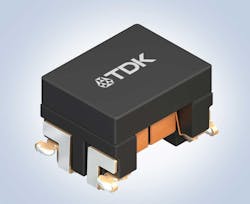The newest member of TDK’s lineup of common-mode filters for 10BASE-T1S automotive Ethernet systems, designated ACT1210E-131-2P-TL00, lowers the line-to-line capacitance by approximately 30% based on the OPEN Alliance EMC test specification for common-mode chokes (CMCs). The standardized measurement specification outlines the recommended characteristics of CMCs for automotive Ethernet.
Notably, in the OPEN Alliance EMC test specification for CMCs the part also achieves Class IV status with the lowest parasitic capacitance—said to be an industry first. Common-mode inductance at 100 kHz is 130 µH, and the rated current is 70 mA.
Responding to the need to save space in electronic control unit (ECU) circuit boards, the ACT1210 series reduces mounting area by over 40% as compared with existing products. Typically, shrinking the component size would have some impact on the common-mode filter’s characteristics. In this case, however, TDK adopted a new technology for the structure and a new core material. In turn, the ACT1210E-131-2P-TL00 filter reduces line-to-line capacitance by about 30% compared to conventional products.
Parasitic capacitance or stray capacitance is the unavoidable and usually unwanted capacitance that exists between the parts of an electronic component or circuit simply because of their proximity to each other. Such capacitance occurs when two electrical conductors at different voltages are close together, causing an electric field to store an electric charge between them.
The Rise of 10BASE-T1S Networking
Ethernet for automotive networks is among the major changes occurring in vehicle architecture with 100BASE-T1 (100 Mb/s) and 1000BASE-T1 (1 Gb/s) being installed for sensor systems in cameras, radar, and LiDAR. Not to be outdone, 10BASE-T1S, a new standard for automotive Ethernet with a transmission speed of 10 Mb/s, is gaining considerable attention.
10BASE-T1S is used to expand Ethernet to the edge of networks. When the network consists of incompatible devices and different physical hardware, this technology eliminates the need for gateways to interconnect incompatible communication systems. Established by IEEE, 10BASE-T1S reduces total system cost by using a single pair of wires and a multidrop bus architecture.
10BASE-T1S technology provides a multidrop transmission medium that can include up to at least eight transceiver nodes. The transceiver nodes connect to a common mixing segment of up to at least 25 m. It’s also possible to use more than eight nodes and transmit over longer distances.
The communication circuit of 10BASE-T1S has PHY, ESD suppression devices, and other electronic components in addition to common-mode filters, each of which has its own capacitance. As capacity increases, so does signal wave shape turbulence, which leads to disruptions in normal telecommunications. For this reason, engineers need to select components geared to low capacitance.
10BASE-T1S was established as part of the IEEE 802.3cg standard. It uses an unshielded twisted-pair (UTP) cable with two unshielded cores for communication. Unlike 100BASE-T1 and 1000BASE-T1, which are one-to-one peer-to-peer connections that require a switch for network configuration, 10BASE-T1S can perform multidrop connections without the need for a switch, thus reducing cost.
Since 10BASE-T1S adopts a multidrop connection without a switch, when many ECUs are connected on one line, reflections due to the length of the wire harness and branches as well as the capacitance component of the ECUs become bigger. This may then cause ringing due to the communication waveform.
That’s why common-mode chokes for EMC measures must have as low interline stray capacitance as possible. TDK notes that its common-mode choke coils are designed to have both excellent interline stray capacitance and mode-conversion properties, making them well-suited for 10BASE-T1S.
What Reduced the Capacitance?
According to TDK, the smaller size and low magnetic resistance (high common-mode inductance) was achieved as a result of using a unique core structure, new ferrite material, and high precision automatic wire winding system, among other reasons. The part is said to feature excellent thermal resistance through the use of wire with high heat resistance.
TDK ‘s lineup of common-mode filters for automotive applications is compliant with the currently mainstream CAN, CAN FD, and FlexRay protocols. They’re also compliant with Ethernet protocols such as 100BASE-T1 and 1000BASE-T1.
In addition, the filters are compliant with AEC-Q200 Rev. D. This standard tests the ability of passive electronic components to withstand the temperature and physical stresses of an automotive environment.
Mass production of this new common-mode filter began July 2024.

